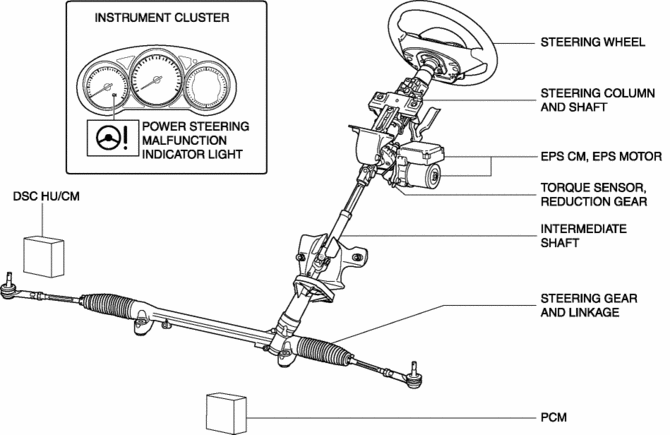Mazda CX-5 Service & Repair Manual: Electric Power Steering System
Outline
-
A column assist type EPS has been adopted for all models.
-
EPS provides smooth handling from low to high speeds as a result of the excellent steering feel provided by the electronic control and the vehicle-speed responsive control.
-
EPS does not require a power steering oil pump and generates assist force only when the steering wheel is steered. As a result, engine load is lowered and fuel efficiency is improved.
-
Serviceability improved by the automatic configuration function and the steering angle neutral position auto-learning function.
Structural View

System Wiring Diagram

Purpose/Function
-
The EPS assists the manual steering mechanism operation using the EPS motor to provide supplemental manual power during steering operation, reducing the load on the driver.
Construction
-
The EPS consists of the following parts:
-
Manual steering mechanism
-
Consists of the steering wheel, steering column, steering column and shaft, steering gear and linkage.
-
Electric assist mechanism
-
Consists of the EPS CM (control module) built in the steering column, torque sensor, reduction gear, and EPS motor integrated in the EPS CM.
-
Control system
-
Controls based on the EPS CM, torque sensor, reduction gear, EPS motor, and vehicle speed and engine speed signals input from the PCM.
Operation
1. Steering force generated by the driver's steering wheel operation is detected by the torque sensor which is built in the steering column and shaft, and is output to the EPS CM as a steering torque signal.
2. The EPS CM calculates optimum assist force based on the steering torque signal from the torque sensor and the vehicle speed and engine speed signals from the PCM, and outputs electric current to drive the EPS motor.
3. The EPS motor is driven by the current from the EPS CM and the force is transmitted to the intermediate shaft via the reduction gears, thus assisting steering operation of the driver.

 Electric Power Steering (Eps) Motor
Electric Power Steering (Eps) Motor
Purpose, Function
The EPS motor is driven by the control current from the EPS CM (control module)
and generates assist torque to manual steering mechanism.
Construction
The EPS ...
 Eps Control Module Inspection
Eps Control Module Inspection
1. Remove the driver-side front scuff plate..
2. Remove the driver-side front side trim..
3. Remove the car-navigation unit (with car-navigation system)..
4. Remove the switch panel..
5. Remov ...
Other materials:
Theft Deterrent Horn Inspection
1. Disconnect the negative battery cable..
2. Remove the following parts:
a. Trunk end trim.
b. Rear scuff plate (RH).
c. Trunk side trim (RH).
d. Theft-deterrent horn.
3. Apply battery positive voltage to horn terminal A, and connect the horn retaining
bolt to ground as shown in the f ...
Rear Upper Arm Removal/Installation [2 Wd]
WARNING:
Verify that the crossmember is securely supported by a jack. If the rear
crossmember falls off, it can cause serious injury or death, and damage to the
vehicle.
CAUTION:
Performing the following procedures without first removing the rear ABS wheel-speed
...
Rear Brake (Disc)
Purpose/Function
Large diameter, solid-disc type front brakes with a 303 mm {11.9 in} diameter
and 10 mm {0.39 in} thickness have been adopted, improving braking force and
fade resistance.
Construction
Operation
When brake fluid is applied, the piston equipped on one s ...
